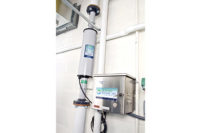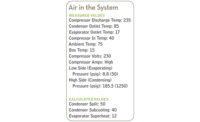
Ferris State University students in the Associates Program in HVACR are getting ready to retrofit one of the two medium-temperature commercial refrigeration cases in the lab from HCFC-22 to R-438A. (Photo courtesy Ferris State University)
But first, a few words about R-134a and R-404A. R-134a is a pure compound containing only fluorine, carbon, and hydrogen. R-404A is a ternary blend of -125, -143a and -134a, and all three HFC molecules contain only fluorine, carbon, and hydrogen.
Back in 1997, all of Ferris State University’s refrigeration and air conditioning application labs in the associate degree program went totally chlorofluorocarbon- (CFC) free. The students in the associate's degree program did all of the retrofitting, giving them valuable real-world experience in retrofitting refrigerant systems and the associated oils. In 1997, entire classes were involved in the retrofitting procedures, and strict retrofit guidelines from compressor manufacturers were followed. The retrofitting allowed students to gain more experiences in:
• Refrigerant recovery;
• Soldering and brazing;
• Evacuation;
• Following retrofit guidelines;
• Draining oil from compressors;
• Adding oil to compressors;
• Changing driers;
• System charging;
• Leak checking; and
• Adjusting controls.
The United States Environmental Protection Agency gave R-22 extra time for its phaseout dates because it had lower ozone depletion potential (ODP) and global warming potential (GWP) numbers than many other refrigerants. Because of this, R-22 has been used in Ferris State University’s air conditioning lab along with R-410A, which is a 50/50 mixture of HFC-32 and HFC-125.
The commercial refrigeration lab at Ferris State only had two units running on R-22 up until late April 2011 when students retrofitted both of these units to R-438A. The students again gained valuable real-world experiences with retrofitting refrigeration systems to different refrigerants.
R-438A RETROFITTING PROCEDURES
R-438A was chosen over other R-22 retrofit refrigerants because of its ease of retrofitting. It is versatile and can be used for retrofitting R-22 DX systems in air conditioning applications (high temperature) and medium- and low-temperature refrigeration applications. No oil changes or TXV changes are required. R-438A is compatible with mineral oil (MO), alkyl benzene (AB), and polyolester (POE) oil. All that was required in Ferris’ Commercial Refrigeration lab retrofits were new standard filter driers and the Schrader valve cores replaced.Listed below are brief retrofit procedures involved when replacing R-22 with R-438A:
• Recover the R-22.
• Replace critical elastomeric seals and filter drier.
• Evacuate the system to 500 microns or below.
• Charge with R-438A. (Since R-438A is a near-azeotropic refrigerant blend, it must be liquid charged.)
• Start up the system and monitor temperatures and pressures.
• Leak check the entire system. And
• Optimize control set points if needed; none upfront.
MORE SPECIFICS ON R-438A
R-438A is an R-22 retrofit refrigerant blend consisting of -32/-125/-134a/-600/-601a. The weight percentages of the five components are 8.5/45.0/44.2/1.7/0.6 respectively. R-600 is the hydrocarbon (HC) butane and R-601a is the hydrocarbon isopentane. These two hydrocarbons constitute a very small percentage of the total blend (1.7 and 0.6 percent) respectively, but this small amount helps thin the MO so it has a lower viscosity, enhancing oil return to the compressor’s crankcase. This characteristic was intentionally designed into the blend to achieve MO compatibility, which many other retrofit blends lack. Because of the small percentages of these two hydrocarbons, R-438A is not flammable. Its ASHRAE safety group classification is A1.R-438A is versatile and can be used for retrofitting R-22 DX systems in air conditioning applications (high temperature) and medium- and low-temperature refrigeration applications. R-438A is Significant New Alternatives Program (SNAP)-approved for sale in the United States.
The evaporator and condenser temperature glide is typically in the 6 to 7°F range. R-438A, as well as most refrigerant blends, is not recommended for use in systems with a flooded evaporator or a centrifugal compressor, as the vapor/liquid composition difference associated with the temperature glide may inversely impact performance.
R-438A has a zero ODP. Its GWP is 1,890 according to the Second Annual Report. The GWP according to the AR4 is 2,264.
R-438A has similar pressure and enthalpy characteristics compared to R-22 in low-, medium-, and air conditioning applications. It is compatible with MO, AB, and POE through all of the above-mentioned temperature ranges.
For most systems, R-438A may have 5 percent to 10 percent lower capacities with similar Energy Efficiency Ratio (EER) when compared to R-22. Because most R-22 systems in service today have excess compressor capacity, this small percentage in capacity loss will not be significant. The compressor simply runs a small amount longer each cycle. The mass flow R-438A is only slightly higher than R-22 to achieve the same refrigeration capacity, so existing TXVs can be used with minimal adjustment to the superheat setting.
ADVANTAGES
R-438A can be used as a retrofit refrigerant blend in air conditioning and refrigeration applications with minimal system changes. The bullet list below lists some advantages of using R-438A in most R-22 system retrofits.• No expansion valve or expansion valve power element change is needed.
• No suction or liquid line set changes are required.
• No oil change is necessary; it is compatible with MO, AB, and POE.
• It is nondisruptive, meaning no strainer plugging especially with TXVs and EPR valves.
• It needs a filter drier change, but it can use a standard filter drier.
• Only minimal set point adjustments are required, if any.
• There is only a 3- to 6-psi head pressure difference when compared to R-22.
• Only a 2-3 psi evaporator pressure difference exists when compared to R-22.
• It offers comparable energy consumption when compared to R-22.
• In refrigeration retrofits, R-438A has a very low carbon footprint. Its GWP is 42 percent lower than R-404A. And
• It is very low first-cost retrofit in a/c and refrigeration applications.
A couple of notes: When retrofitting R-22 systems to R-438A, or any HFC refrigerant, it is recommended that critical elastomeric seals such as Schrader valves and liquid level indicators be changed. And always consult with the compressor manufacturers or follow their specific retrofit guidelines and procedures before performing a retrofit on any R-22 system or any other refrigeration system.
R-22 SHORTAGES
Beyond the environmental issue related to HCFCs, it should also be noted that there is an estimated 900 million pounds of R-22 installed in refrigeration and air conditioning systems in the United States. It is also estimated that 85 percent of this R-22 is installed in a/c applications and 15 percent in refrigeration applications. It is estimated that the demand for R-22 will be 137 million pounds; however, the supply of R-22 will be only 110 million pounds. These statistics make it obvious that there is a need for an R-22 retrofit refrigerant.Most new air conditioning systems today will be manufactured with R-410A refrigerant. Today, many air conditioning systems will be retrofitted with a refrigerant blend. However, there is not one perfect refrigerant blend that will be a perfect drop-in replacement for retrofitting R-22 systems. Each refrigerant blend has advantages and disadvantages. These advantages and disadvantages have to be balanced to choose the best overall choice for your specific application. R-438A is one of the leading refrigerant blend candidates for retrofitting R-22 systems for both a/c and refrigeration applications.
Publication date:06/06/2011










